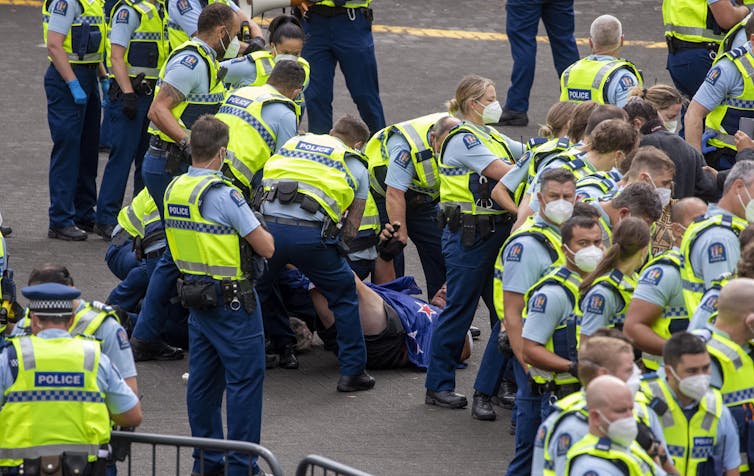The continued occupation of parliament’s grounds by anti-vaccine mandate protesters (and others) provides a unique problem for police: how to lawfully and legitimately remove the occupiers without making the situation worse.
The Speaker of Parliament has authorised police to clear the grounds, which grants the operation legitimacy. But tactically the options are not as clear-cut.
In the background is an ever-present policing conundrum: taking action in favour of one group within society risks alienating another. The longer police tolerate the occupiers’ right to protest, the more frustrated the affected homeowners, businesses and workers become.
Some commentators and critics (especially on social media) have been quick to criticise police command decisions and the seeming unwillingness to use more force. But weighing up the rights of competing groups is never simple.
Nor is undertaking an operation that risks injury to police personnel (and protesters), and where perceived excessive force can lead to subsequent legal action against individual officers.

Logistical impossibilities
Despite the standoff, however, police and parliamentary security have successfully prevented the breach of parliamentary buildings – something that would have been on the minds of security planners since the storming of the US Capitol in Washington DC a year ago.
But police also face the problem of the occupiers’ unclear objectives and the apparent lack of leadership with whom to negotiate. The disparate motives of the various protest groups preclude the kind of rational negotiation that would normally be undertaken in a siege situation.
Widespread arrests might be lawful, but appear logistically impractical. The arrest, custody and charging process is resource-heavy (especially when those arrested refuse to comply with vaccination or mask mandates).
Even moving occupiers’ vehicles has been a challenge beyond the capabilities of the Wellington Council and adding to police concerns.
Moreover, the arrest of 122 people last Thursday did not result in the remaining body of occupiers dispersing. There have been reports some of those arrested and bailed have returned to the site, contrary to their bail conditions.
And the parliamentary speaker’s own tactics (not endorsed by police) of turning on the ground’s water sprinklers and playing supposedly annoying music over the PA system have not worked, either.
The arrests, charges, court appearances and even Barry Manilow have not acted as a sufficient deterrent, and have possibly even hardened protesters’ resolve. Clearing the occupation in a way that prevents protesters from returning to the site simply adds another layer of challenge.
Managing perceptions
All force used by police must be necessary, proportionate and reasonable in the circumstances. Police will be rightly cautious about this, given the presence of children and young people at the site.
Furthermore, the actions of the protesters sit within the definitions of passive resistance (refusing to comply with verbal directions to move) and active resistance (pulling or pushing away). Even in the face of someone resisting arrest, force by police must be proportionate to the resistance offered.
As such, police procedure limits officer responses. For officers to employ tactics involving the use of weapons – batons, sprays or tasers – they would need to be responding to more assaultive behaviours from individual protesters.
Read more: Canada's trucker protest: An epic security failure or a triumph of democratic freedom?
Force used to arrest those who have made death threats against MPs and media must also be made on the same basis of being proportionate and necessary. Police would need to weigh up the likelihood of a threat to justify immediate action.
Less common paramilitary-style tactics were on display last Friday when some police carrying batons assembled, again fodder for mainstream and social media debate.
Squads marching into position like this are a necessary overt display of organised coercive power in response to a perceived level of threat. But they have the potential to be portrayed as state oppression – something police commanders are aware of. The same day batons appeared, the Wellington police district commander instructed officers not to carry them.
A waiting game
How to break such an impasse? Parliament could pass emergency legislation giving police special powers to use all force necessary to clear and detain protesters en masse.
But such a tactic would be an affront to the constitutional and constabulary independence of police that is valued in Aotearoa New Zealand. As the Policing Act specifically prohibits ministerial interference in operational matters, some might perceive emergency legislation as an overreach.
Using chemical irritants like pepper spray may well disperse the crowd but might also only displace the problem to another site, with police bound to provide aftercare and medical treatment.
Mounted police units, as used by Australian and British police, are an effective means of moving large groups of people, but no such capability exists in New Zealand.
The problem will not be resolved by arresting every occupier, given the significant financial cost and required resources. The police themselves have acknowledged they cannot arrest their way out of the problem.
Police are well resourced to wait the occupation out. While this might be the safest option, it may not be the most politically amenable one. So far, though, the police can be applauded for their patience, professionalism and commitment to maintaining the peace.

